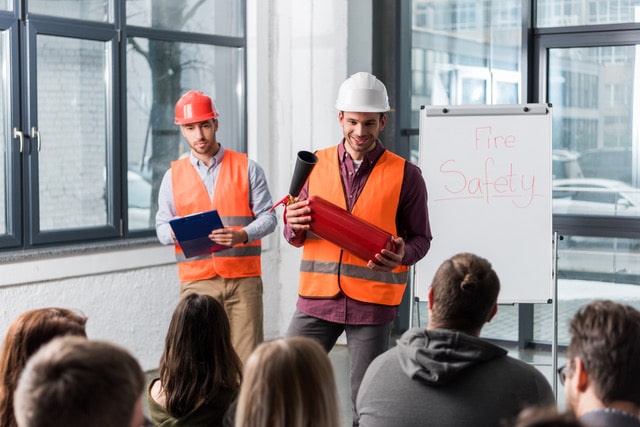A total of 83,098 reportable accidents in 2021 were related to materials handling, transport and storage equipment. Another 21,425 accidents were related to cars and trucks. Together, these accounted for 14.3 percent of all occupational accidents – and 74 people were killed.
Not all of these were explicitly related to logistics. By its very nature, however, it is likely to have played a significant part in this – for example, in the 16,429 accidents that occurred in connection with warehouse equipment alone.
Many of these accidents were undoubtedly preventable. Either if the relevant specifications had been observed or if the employees had been better trained. Especially with regard to the effect of each accident on the company’s image and the recruitment of skilled workers, every logistics manager should therefore be aware of how important it is to have an overall safe working environment. We now show the most important positions for this. Freely adapted from the famous industrialist Werner von Siemens:
“Preventing accidents is not a matter of legal regulations, but of corporate responsibility and, moreover, an imperative of economic sense.”
#1 Following the laws and regulations to the letter
 Since the Prussian Regulativ was issued in 1839 and for the first time restricted child labor, occupational safety and health has undergone a very long development. A development in which accidents often had to occur before the need for improvement was recognized.
Since the Prussian Regulativ was issued in 1839 and for the first time restricted child labor, occupational safety and health has undergone a very long development. A development in which accidents often had to occur before the need for improvement was recognized.
The regulations in force today can therefore be regarded with confidence as the combined experience of almost 200 years of industrial history. They are therefore not regulations drawn up by theorists who are far removed from practice, but all things that are based directly on practical and often painful experience. Let’s take the specifications for the marking of machines. The standards behind them, as well as the colors, graphic elements, lettering and, last but not least, the locations where they are to be affixed, are all directly influenced by occupational accidents and by scientific analyses of how these can be prevented in the future.
The scope of all these regulations in the logistics sector is so extensive that it would go far beyond the scope of this article. Therefore, only the most important requirements are listed here:
- The basic set of rules and regulations of the German Social Accident Insurance (DGUV).
- The specifications from the trade and logistics department of the DGUV.
- The Technical Rules for Workplaces (ASR) and similar regulations from the Trade Association for Trade and Merchandise Logistics (BGHW).
- Sections 30 and 31 of the German Road Traffic Licensing Regulations (StVZO), Sections 22 and 23 of the German Road Traffic Regulations (StVO), and Section 412 of the German Commercial Code (HGB).
- The guideline VDI 2700 of the Association of German Engineers (VDI).
All these works are ultimately based on corresponding federal laws. They are either their standardized, detailed implementation or works that assist in such implementation. Fulfilling them to the letter is the duty of every company – to itself and to its employees. Not because failure to comply could result in penalties following accidents.
#2 Professional and proper training of employees.
Based on the various specifications, there is a strict rule of law that applies in every logistics company and in every profession carried out in it, without exception:
- Every employee who is new to the company must be familiarized with occupational safety and health protection under the company’s conditions as part of initial training.
- Each employee must also be instructed again at least once a year based on the Occupational Health and Safety Act.
- Furthermore, such instruction is mandatory whenever areas of responsibility change or new operating equipment/technologies are introduced.
Although the relevant specifications specify the topics on which employees must be instructed, they do not specify any more. In practice, this leaves an unfortunately dangerous gap: The quality of instruction, and thus its effectiveness, can vary extremely; depending on who does it and how.
A bad, boring instruction certainly fulfills the legal obligation to provide evidence. However, it is absolutely not goal-oriented. Much like virus protection that is installed but constantly turned off.
To ensure that employees really learn something that is maximally beneficial to safety instead, there are only two options:
- Selected employees take part in workshops and seminars organized by the employers’ liability insurance association.There they become capable instructors who can plan and carry out effective instruction. Advantage: Since they are employees of the company themselves, they can address company-specific features and their colleagues very well.
- The instructions are carried out by external professionals.Since they do nothing else, they are mostly pronounced routiniers in adult education and occupational safety. Therefore, their instructions are likely to be among the best possible. Disadvantage: They are not as familiar with the company and the employees, which can lead to a certain aloofness.
Once again, we would like to emphasize what a dramatic difference good, exciting, and even enjoyable instruction can make in everyday safety.It is the only way to encourage people to listen, think, reflect – and, above all, to follow.
#3 Make safety pleasant
Suppose that safety shoes are required to be worn in the warehouse. Since it is mandatory, the employer must provide and finance the shoes. Now there are two options:
- Cheap boots are purchased that only meet the required protection class, but are neither high quality nor durable.
- Expensive boots are purchased that provide a high degree of ergonomics in addition to protection. Moreover, not only different foot lengths are considered in the purchase, but also foot widths.
 In the first case, there may well be situations in which employees arbitrarily choose not to wear these shoes because they are simply uncomfortable.For example, on the night shift, when it is known to be less stringent almost everywhere – or at the wheel of a truck. Of course, in the event of an accident, the employee would be at fault. However, it is quite obvious how much the actual shoe choice had an effect here.
In the first case, there may well be situations in which employees arbitrarily choose not to wear these shoes because they are simply uncomfortable.For example, on the night shift, when it is known to be less stringent almost everywhere – or at the wheel of a truck. Of course, in the event of an accident, the employee would be at fault. However, it is quite obvious how much the actual shoe choice had an effect here.
This example can be applied far beyond the topic of protective clothing. There is always a maxim behind it: anything that promotes safety should be maximally comfortable, convenient and conducive to work processes, rather than a hindrance to them. The less safety is perceived as a hurdle or a disruption, the more willing everyone is to participate – awareness at its best.
Last but not least, this should include leaving options open – for example, when waistband or dungarees and, in hot temperatures, sometimes even appropriate shorts may be worn. Here, the idea of safety should take precedence over corporate identity.
#4 Establish a culture of response
Many people tend to take the path of least resistance when it comes to work.Sometimes this is compounded by personal experience – and sometimes by an unwillingness to change.These are not always matters relevant to occupational safety, but often enough.
Especially where superiors are far away, such behavior can exist for months, even years, until it results in an occupational accident in the most inappropriate chain of circumstances.
Supervisors can’t be everywhere.And if they are, they can’t pay attention to every detail of correct behavior in every employee.For this reason in particular, a culture of responsiveness should be established in logistics operations:
- At every single level in all departments.
- On both sides without regard to standing, department or length of service.
- Related to both positive and negative behavior.
In case of doubt, everyone should therefore point out correct and incorrect behavior to everyone else – even if it is a second-year apprentice who points out to an experienced colleague that it would be better to wear a helmet on the forklift.
However, under no circumstances should this be perceived as an attempt to “spy” on each other. It must be clear to everyone involved how important and correct such behavior is. After all, anyone who behaves unsafely can trigger a work accident from which everyone suffers; possibly even scarred for life.
Therefore, correct behavior must never be taken for granted, but must be emphasized as well. Already after shortest time a self-educating effect develops from it in colleague circles.
#5 Exercise role model functions
The company owner always wears only his shimmering bald head instead of a helmet during his morning tour of the high-bay warehouse. The warehouse manager forgets far too often to change her clogs for safety shoes when she comes out of her office. And the apprentice in his final year of training is only too happy to show his younger colleagues how to carry more packages through the hall with fewer trips and why the pallet truck is an excellent roller when empty.
These kinds of things are an everyday reality in very many logistics companies in various forms. Supervisors and managers consciously or unconsciously fail to behave in a work-safe manner – and thus quickly communicate a fatal message.
The reverse should be the case: Everyone in the company who has a role model function should fulfill this function ostentatiously, especially when it comes to occupational safety. After all, if “the boss” is already not behaving correctly, many employees see no reason to do otherwise.
In summary
The guidelines on the subject of occupational safety and health from painful experience are very comprehensive and practical. However, they can never take into account all eventualities and prescribe every detail meticulously.
Therefore, it is up to each individual company to make its employees aware of these issues and encourage them to be constantly vigilant. A large part of occupational safety depends on each individual – and cannot be delegated.









